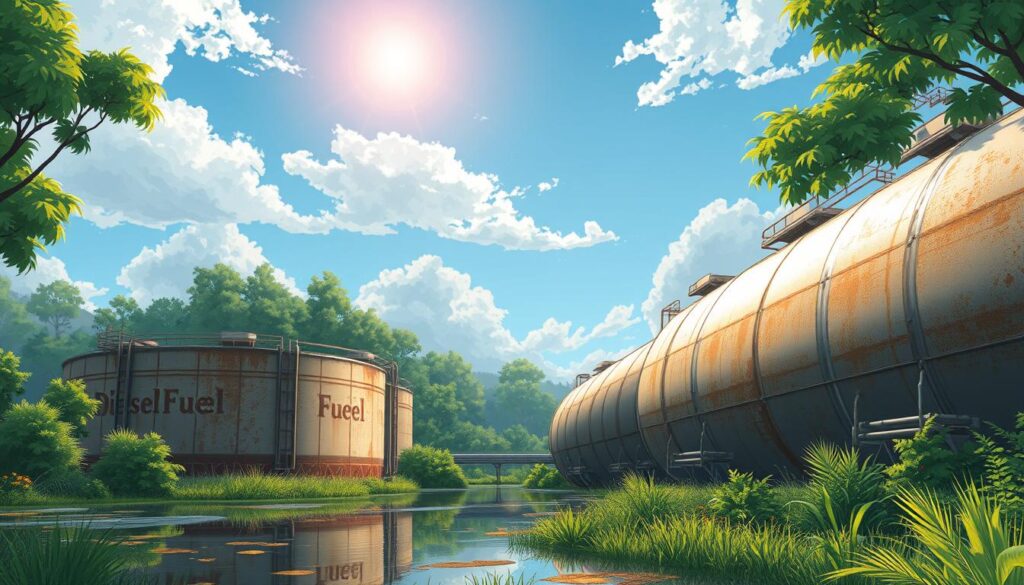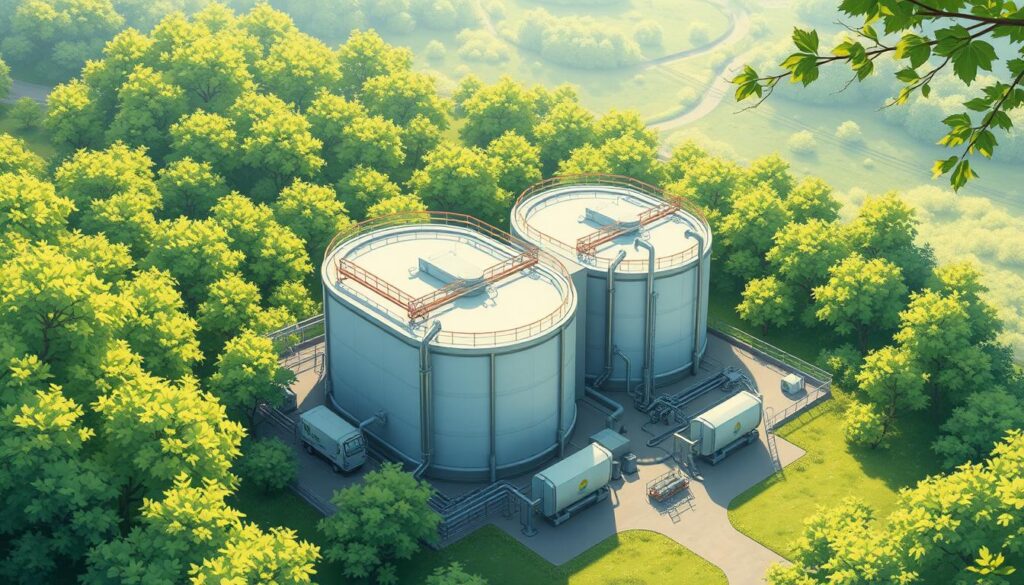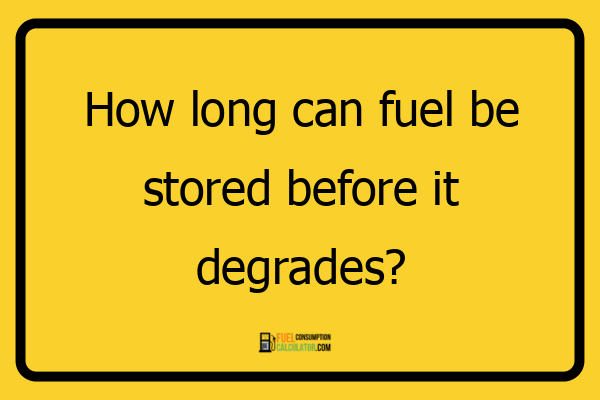Storing fuel like gasoline and diesel is important. These fuels can last 6 months to 1 year if kept in clean, sealed containers away from sunlight and heat. But, if not stored right, they can break down fast.
Fuel can degrade quickly if it’s exposed to oxygen, moisture, or dirt. Pure gasoline can start to break down in 3-6 months. Ethanol-gasoline blends last even less, just 2-3 months. But, if you add special additives, fuel can last 1-3 years.
Diesel fuel #2 is especially sensitive and can get contaminated and degrade in 28 days. On average, diesel can last 6-12 months. But, experts like NFPA 110 suggest it should last 1.5 to 2 years. Things like moisture, bacteria, and oxidation can make diesel go bad in 6 months.
Contents
Key Takeaways
- Gasoline and diesel can be stored for 6 months to 1 year without significant degradation when properly contained.
- Fuel exposed to oxygen, moisture, or contaminants can degrade much faster, with pure gasoline degrading in 3-6 months and ethanol-gasoline blends in 2-3 months.
- Diesel fuel #2 begins to degrade and become contaminated within 28 days of storage, with an average storage life of 6-12 months.
- Threats like hydrolysis, microbial growth, and oxidation can lead to diesel degradation in as little as 6 months.
- Proper storage conditions and fuel treatment are crucial for extending the shelf life of all fuel types.
Understanding Fuel Degradation
Fuel degradation happens when fuel meets the environment. This process breaks down the fuel’s chemical makeup. It affects the fuel’s quality and how well it works. Knowing why and how fuel degrades helps keep engines running well and avoids expensive fixes.
What Causes Fuel to Degrade?
Heat, light, oxygen, moisture, and microbes cause fuel to degrade. These elements start chemical reactions. This leads to gum, sludge, and more acidity in the fuel.
Types of Fuel Degradation
- Fuel Oxidation: Fuel reacts with oxygen, making gum and sludge. This can block fuel filters and injectors.
- Fuel Hydrolysis: Water makes fuel break down. This creates acids and corrosive compounds.
- Fuel Microbial Growth: Bacteria and fungi in fuel make acids. These degrade the fuel and block filters.
| Fuel Type | Shelf Life Recommendations | Degradation Concerns |
|---|---|---|
| Petro Diesel and Biodiesel Blends | Less than 1 year | Oxidation, Hydrolysis, Microbial Growth |
| Ultra-Low Sulfur Diesel (ULSD) | As low as 2 months without stabilizer | Oxidation, Hydrolysis, Microbial Growth |
| Gasoline | 3-6 months (without ethanol), 3 months (with ethanol) | Oxidation, Evaporation, Water Contamination |
Knowing the main causes and types of fuel degradation helps you protect your fuel. This keeps your fuel supply lasting longer and working better.
How Long Can Fuel Be Stored Before It Degrades?
Understanding how long fuel lasts is key when storing it. The shelf life of fuel varies a lot. Keeping fuel right helps prevent it from breaking down and keeps it usable.
Gasoline doesn’t last long in storage. It can last 6 months to 1 year. Ethanol-gasoline blends last only 2-3 months. But, stabilized gasoline can last 1-3 years if stored right.
Diesel fuel has a complex storage timeline. In the 1950s, the US Army said diesel fuel could last 3-5 years or more. But now, it doesn’t last as long. Common diesel fuel may last 18-24 months, with problems starting at 12-18 months.
- Diesel fuels with 3-5% biodiesel may have a shorter storage life due to increased water retention and microbial problems.
- Refineries now achieve 93% distillate content in diesel fuels through specialized chemical reactions, making them less stable and more reactive than in the past.
- Incorporating diesel fuel stabilizers is a recommended best practice for extending the storage life of diesel fuel.
On average, diesel fuel can last six to twelve months with proper storage and maintenance. The shelf life depends on biodiesel, microbial growth, and how well you remove water.

To keep your fuel fresh, store it in proper containers like 55-gallon drums or fuel tanks. Keep the storage area cool, dry, and shaded. Using biocides and stabilizers can also help. And, getting fuel polishing and tank cleaning services can fix contaminated fuel.
Factors Affecting Fuel Storage Life
The life of stored fuel depends on several important factors. These include the fuel type and composition, as well as the storage conditions. Knowing these factors helps keep your fuel supplies fresh and extends their shelf life.
Fuel Type and Composition
The type of fuel and its mix can greatly affect how long it lasts. Diesel fuel usually lasts 6 to 12 months under the best conditions. But, high temperatures can make it break down faster.
Gasoline degrades quicker than diesel. Pure gasoline can last 3 to 6 months in a sealed container. But, if it has ethanol, it lasts only 2 to 3 months. Using fuel stabilizers can help keep gasoline good for 1 to 3 years under the right conditions.
Storage Conditions
Where you store fuel is key to its shelf life. Diesel fuel should be kept in a cool, dry spot away from sunlight and big temperature changes. Using a “first-in, first-out” system helps use older fuel first.
Water is a big problem for diesel fuel. It can cause bacteria to grow, corrode, and break down the fuel. Checking storage tanks for water and using clean containers is important.
For gasoline, it’s important to label and store it right to avoid using old fuel. Gas in a car tank can get bad in about a month. Storing more than five gallons in a container is risky because it can be too volatile and might explode.
“Implementing a ‘first-in, first-out’ system can ensure the usage of older fuel before newer supplies.”
Preventing Fuel Degradation
Keeping fuel fresh is key to reliable performance and avoiding engine problems. Fuel can degrade in just six months, showing the importance of taking steps early. By knowing what causes fuel to break down and using the right strategies, you can keep your fuel fresh longer and protect your equipment.
Using Fuel Stabilizers
Fuel stabilizers are vital in stopping fuel from degrading. They have antioxidants and agents that stop oxidation and keep water out of the fuel. Adding a good stabilizer to your fuel can make it last longer and work better when you need it.
Proper Storage Practices
- Keep fuel in cool, low-oxygen places to slow down oxidation and evaporation.
- Make sure your storage tanks are strong to keep water out, which can cause fuel to break down.
- Use biocides to stop microorganisms from growing in the fuel.
- Clean your storage tanks often to get rid of sediment that can harm the fuel.
By doing these things, you can stop fuel from degrading and keep your equipment running well for a longer time.

“Preventing fuel degradation is more cost-effective than trying to reverse it, with methods like using stabilizers, removing water phases from tanks, and applying biocides to control microbial contamination.”
Dealing with fuel degradation can be expensive, but using fuel stabilizers and proper storage can help. These steps protect your fuel and keep your equipment reliable. Making these investments now can save you time, money, and trouble later.
Legal and Regulatory Considerations
Storing fuel requires knowing the laws and rules. These cover storage, handling, and moving fuels. They aim to keep us safe and protect the environment.
The EPA’s SPCC rule has rules for big fuel storage operations. OSHA sets safety standards for flammable liquids like gasoline and diesel. The NFPA gives advice on handling flammable liquids.
Following these rules is key to avoid fines and penalties. You should know the rules in your area, as they might be different. By staying updated and following best practices, you can store fuel safely and responsibly.
Source Links
- https://axi-international.com/the-shelf-life-of-fuel-how-long-can-gasoline-and-diesel-be-stored/ – How Long Can Fuel Really Be Stored For?
- https://www.wpowerproducts.com/blog/generator-engine-fuels/how-long-can-you-store-diesel/ – How Long Can You Store Diesel Fuel & How to Make it Last Longer
- https://www.donaldson.com/en-be/bulk-fluid-storage/technical-articles/fuel-degradation/ – The Degradation of Fuel Over Time│Donaldson Engine & Vehicle
- https://www.neighbor.com/storage-blog/how-long-can-gas-sit-in-a-car/ – How Long Can Gas Sit in a Car Before it Becomes Unusable? – Neighbor Blog
- https://www.livescience.com/58117-does-gasoline-go-bad.html – Does gasoline go bad?
- https://www.bellperformance.com/bell-performs-blog/how-long-does-diesel-fuel-last-in-a-storage-tank – How Long Does Diesel Last In A Tank?
- https://hartfueling.com/how-long-does-diesel-fuel-last-in-storage/ – How Long Does Diesel Fuel Last In Storage? – Hart Fueling Service
- https://greensenergy.com/blog/how-long-does-diesel-last/ – How Long Does Diesel Fuel Last?
- https://rislone.com/blog/fuel-system/does-gasoline-go-bad/ – Does Gasoline Go Bad? | Rislone
- https://fosterfuels.com/blog/avoid-diesel-fuel-degradation/ – How to Avoid Diesel Fuel Degradation – Mission Critical
- https://www.bellperformance.com/bell-performs-blog/diesel-fuel-degradation-in-storage-the-signs – Diesel Fuel Degradation in Storage – the Signs
- https://valleyfoodstorage.com/blogs/inside-vfs/how-to-store-gasoline-long-term?srsltid=AfmBOoocDemDYOLdG2s9w7sf6XNvJ7GX66r-7jVQxFWjtwFxfPfGY6A1 – How to Store Gasoline Long Term | Tips for Long Term Gasoline Storage – Valley Food Storage
- https://www.grainger.com/know-how/operations/facility/kh-5-tips-safely-store-gasoline-diesel – 5 Tips for Safely Storing Gasoline and Diesel Fuel – Grainger KnowHow

Hi, I’m Sufiyan, the developer behind this platform. I created FuelConsumptionCalculator.com to simplify fuel tracking for everyone — because understanding your vehicle shouldn’t require a degree in mechanics. I’m always working on adding more tools and content to make this site even more useful

